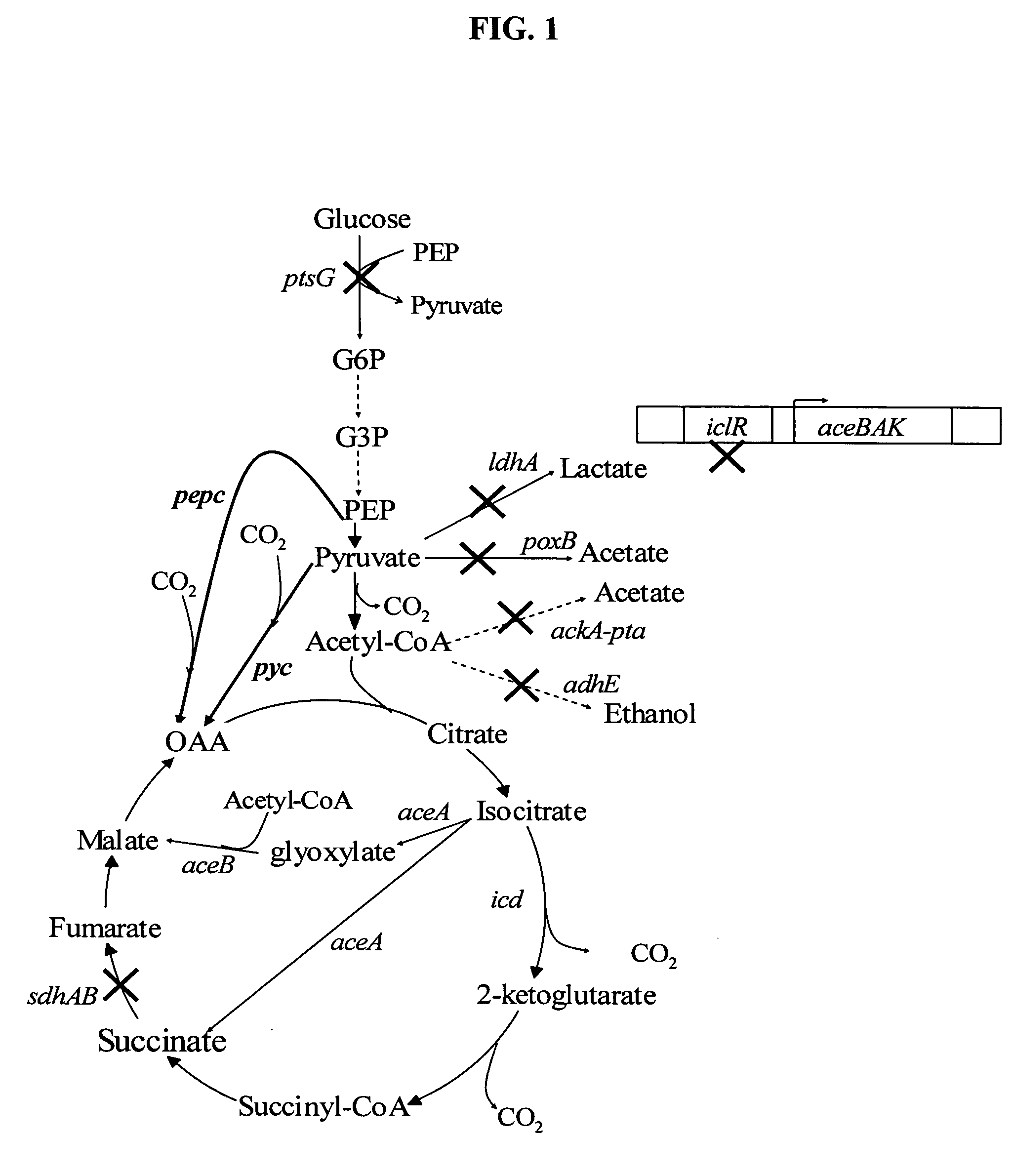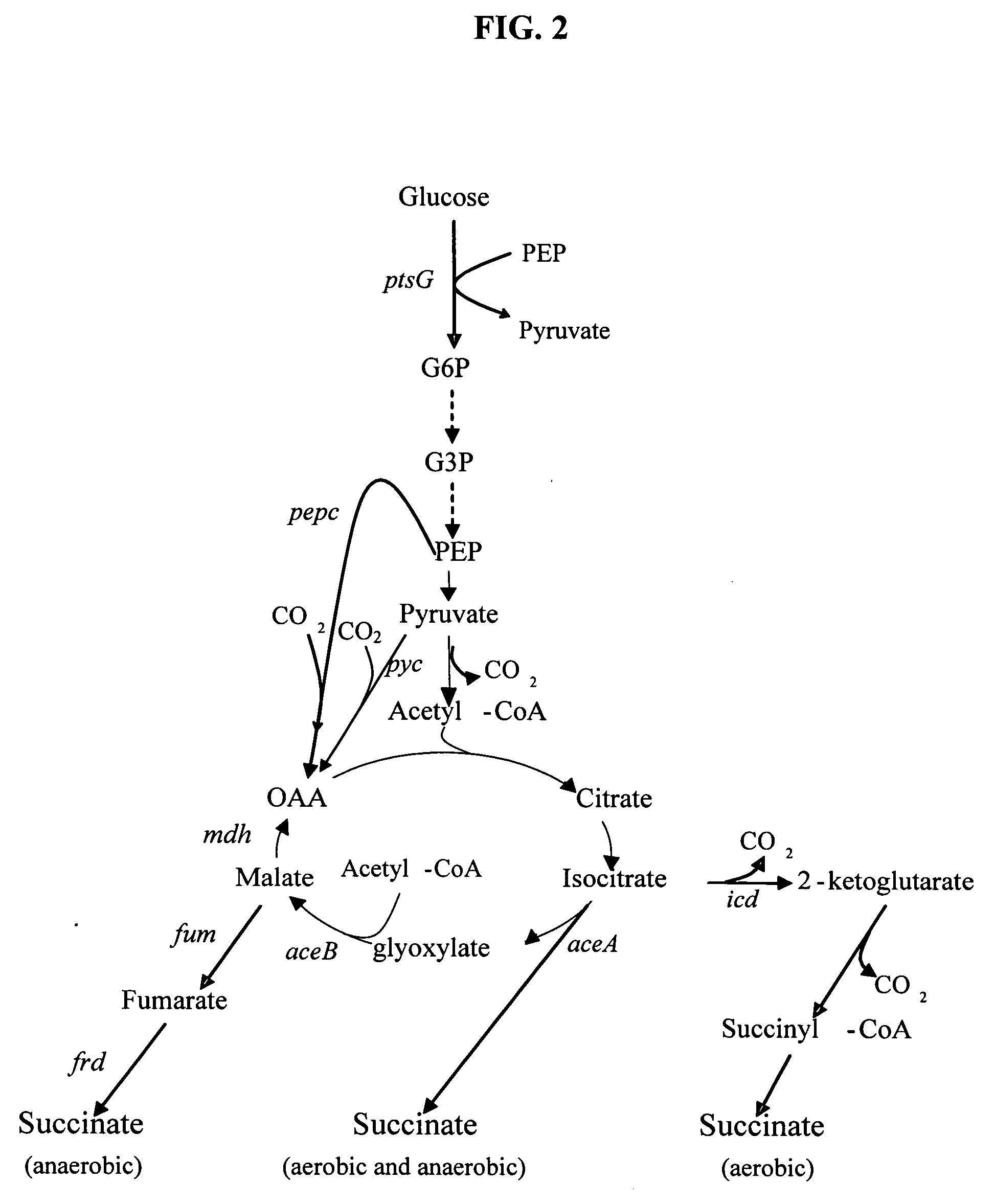High succinate producing bacteria
a technology of high-quality succinate and bacteria, which is applied in the direction of microorganisms, bacteria, microorganisms, etc., can solve the problems of low yield and concentration, large amount of growth substrates such as glucose, and inability to convert to desired products, etc., to achieve the effect of increasing the production of succinate and increasing the yield of succina
- Summary
- Abstract
- Description
- Claims
- Application Information
AI Technical Summary
Benefits of technology
Problems solved by technology
Method used
Image
Examples
example 1
Inhibition of Lactate, Acetate, and Ethanol
[0030] A hybrid bacterial strain that produces carboxylic acids under both aerobic and anaerobic conditions can overcome the anaerobic process constraint of low biomass generation. Biomass can be generated under aerobic conditions in the beginning of the fermentation process. During this phase, carboxylic acids are produced in large quantities by the aerobic metabolic synthesis pathways, saving time and cost. Once high biomass is obtained, the environment can be switched or allowed to convert to anaerobic conditions for additional conversion of carbon sources to carboxylic acids at high yields. Utilizing the redesigned anaerobic succinate fermentative pathways, carboxylic acid yield is expected to increase to much greater than 2 or 3 moles product per mole glucose.
[0031] First, to increase flux toward the TCA cycle for carboxylic acid production, two acetate pathways in the aerobic metabolism are inactivated, pyruvate oxidase (POXB) and ...
example 2
Increasing Flux through the Glyoxylate Shunt
[0035] As has been previously shown, the presence of native ACEA and ACEB are sufficient to drive carboxylic acid production without requiring additional expression. The native expression level is however susceptible to feedback inhibition and is sensitive the aerobic or anaerobic conditions of the environment. Constitutive activation of the glyoxylate bypass is essential to maintain high levels of aerobic metabolism for carboxylic acid synthesis. This activation is made possible by inactivating the aceBAK operon repressor (ICLR). As seen in FIG. 1, activation of the glyoxylate shunt provides both a mixed fermentive environment which achieves high levels of carboxylic acid production.
example 3
Succinate Production
[0036] Inactivation of succinate dehydrogenase (SDHAB) enables succinate accumulation under aerobic conditions (FIG. 1). Succinate normally does not accumulate under aerobic conditions since it is oxidized in the TCA cycle for supplying electrons to the electron transport chain, and for replenishing oxaloacetate (OAA). The branched metabolic pathway demonstrated in FIG. 2, provides an aerobic, anaerobic and constitutive pathway for carbon flux to generate succinate. The presence of dual-synthesis pathways reduces the need for pure aerobic or pure anaerobic culture conditions allowing industrial culture conditions under lower stringency standards.
PUM
| Property | Measurement | Unit |
|---|---|---|
| concentration | aaaaa | aaaaa |
| concentration | aaaaa | aaaaa |
| volume | aaaaa | aaaaa |
Abstract
Description
Claims
Application Information
 Login to View More
Login to View More - R&D
- Intellectual Property
- Life Sciences
- Materials
- Tech Scout
- Unparalleled Data Quality
- Higher Quality Content
- 60% Fewer Hallucinations
Browse by: Latest US Patents, China's latest patents, Technical Efficacy Thesaurus, Application Domain, Technology Topic, Popular Technical Reports.
© 2025 PatSnap. All rights reserved.Legal|Privacy policy|Modern Slavery Act Transparency Statement|Sitemap|About US| Contact US: help@patsnap.com



